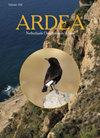法国最大的Lac de Grand Lieu殖民地的大蟾蜍迁徙模式和迁徙记录:不同时间和地理尺度下的密度相关因素
IF 1.3
4区 生物学
Q3 ORNITHOLOGY
引用次数: 0
摘要
自20世纪70年代以来,法国越冬的大蟾蜍Phalacrocorax carbo sinensis的数量急剧增加,主要是由于法国北部国家对“大陆”sinensis亚种的保护。这一增长导致在法国西部建立了一个开创性的内陆繁殖地,而此前只有以海洋为主的“大西洋”P.c.carbo亚种出现在海峡海岸。海洋亚种被吸引并繁殖在这个新的中国内陆定居点,该定居点迅速成为法国最大的殖民地。本文通过分析1989年至2008年间彩环鸟的分布情况,分析了该群落鸟类的迁徙模式。有趣的是,除了典型的西南迁徙模式外,来自该殖民地的鸟类还表现出向东北迁徙的模式,向荷兰等国家迁徙,该殖民地(中华鳖)的创始人可能来自荷兰。观察和恢复显示,大约25%的成年鸟和19%的一年级鸟向东北方向飞去。由于这一东北迁徙方向,全年的总体分散点仅位于殖民地西南50公里处,尽管在12月和1月,这一中点位于殖民地西北约320公里处。这些鸟在很大程度上避开了布列塔尼,可能是为了避免与卡波亚种的个体竞争,以及来自法国(东部、中部和南部)和西班牙其他殖民地的中华鳖的主要越冬区。在1989-2008年的繁殖期,成年鸟的平均传播距离比幼鸟短(分别为54公里和144公里),但在冬季,成年鸟比幼鸟迁徙得更远(分别为305公里和221公里)。冬季的年平均扩散距离从106公里到527公里不等(所有年龄段加在一起)。迁徙距离与冬季平均气温无关。对于成年人来说,1990年至2003年间,Grand Lieu群体的扩散距离与繁殖配对的年数量相关,但2004年至2008年间则不然。截至2011年,有11个内陆殖民地和一个沿海殖民地(比Grand Lieu成立得更近)的移民(在另一个殖民地繁殖)记录,其中9个在法国,2个在西班牙,1个在荷兰。大刘的年移民率与殖民地规模呈负相关。这项研究指出,在繁殖季节之外,密度对Cormorants的分布模式存在依赖性影响,但也表明相距数百公里的群落之间存在连通性和相互作用。本文章由计算机程序翻译,如有差异,请以英文原文为准。
Migration Patterns and Recorded Emigration of the Great Cormorant Phalacrocorax carbo sinensis in the Largest French Colony of Lac de Grand-Lieu: Density-Dependent Factors Operating at Different Time and Geographical Scales
The number of wintering Great Cormorants Phalacrocorax carbo sinensis in France has strongly increased since the 1970s, mainly due to the protection of the ‘continental’ sinensis subspecies in countries north of France. This increase has led to the establishment of a pioneering inland breeding colony in western France, while previously only the largely marine ‘Atlantic’ P. c. carbo subspecies occurred on the Channel coast. The marine subspecies was attracted and bred in this new inland settlement of sinensis, which rapidly became the largest colony in France. This paper analyses the migration pattern of birds from this colony by analysis of the dispersal of colour-ringed birds between 1989 and 2008. Interestingly, besides a classic south-west migration pattern, birds from this colony also displayed a pattern heading north-east, up to countries such as The Netherlands, from where the founders (sinensis) of this colony probably originated. Sightings and recoveries revealed that about 25% of the adults and 19% of the first-year birds headed north-east. Due to this north-east migration direction, the overall annual dispersal point was located only 50 km south-west of the colony, although in December and January this midpoint was located about 320 km south-west of the colony. The birds largely avoided Brittany, presumably to avoid competition with individuals of the carbo subspecies, and the main wintering areas of sinensis from other colonies, both in France (east, centre and south) and in Spain. Over the years 1989–2008, in the breeding period, the mean dispersal distance was shorter for adults than for young birds (54 km vs. 144 km, respectively) but in winter adult birds migrated further than young ones (305 km vs. 221 km, respectively). The mean annual dispersal distance in winter varied from 106 km to 527 km (all age-classes taken together). Migratory distance was not related to mean winter temperature. For adults, dispersal distance correlated with the annual number of breeding pairs in the Grand-Lieu colony between 1990 and 2003, but not between 2004–2008. Emigration (breeding in another colony) was recorded up to 2011 to 11 inland colonies and one coastal colony (founded more recently than Grand-Lieu), nine of them in France, two in Spain and one in The Netherlands. Annual emigration rate was negatively related to colony size in Grand-Lieu. The study points to the existence of density-dependent effects on distribution patterns of Cormorants outside the breeding season but also suggests connectivity and interaction among colonies that are hundreds of kilometres apart.
求助全文
通过发布文献求助,成功后即可免费获取论文全文。
去求助
来源期刊

Ardea
生物-鸟类学
CiteScore
2.10
自引率
0.00%
发文量
49
审稿时长
>12 weeks
期刊介绍:
Ardea is the scientific journal of the Netherlands Ornithologists'' Union, and is published since 1912. The journal welcomes manuscripts reporting significant new findings in ornithology, in particular those covering the ecology, life history, and evolution of birds, and including sound descriptive work. Ardea publishes Original research papers, Short notes and Book reviews. In addition to the regular three issues per year, Ardea publishes specials that contain conference or workshop proceedings (produced on request).
 求助内容:
求助内容: 应助结果提醒方式:
应助结果提醒方式:


